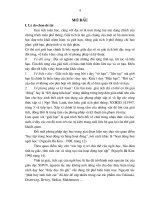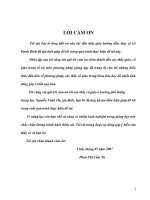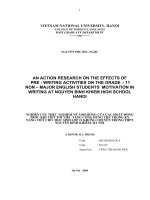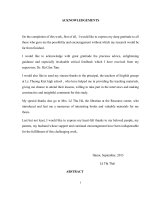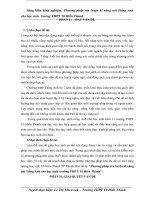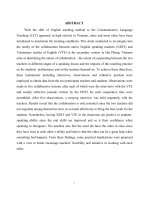Tác động của viết hợp tác tới kỹ năng viết của học sinh lớp 11
Bạn đang xem bản rút gọn của tài liệu. Xem và tải ngay bản đầy đủ của tài liệu tại đây (644.74 KB, 65 trang )
VIETNAM NATIONAL UNIVERSITY, HANOI
UNIVERSITY OF LANGUAGES AND INTERNATIONAL STUDIES
FACULTY OF POST-GRADUATE STUDIES
********************************
NGUYỄN THỊ TÂM
THE IMPACT OF COLLABORATIVE WRITING ON 11TH
STUDENTS’ WRITING PERFORMANCE
(TÁC ĐỘNG CỦA VIẾT HỢP TÁC TỚI KỸ NĂNG VIẾT
CỦA HỌC SINH LỚP 11)
M.A MINOR PROGRAMME THESIS
FIELD
: ENGLISH TEACHING METHODOLOGY
CODE
: 60.140.111
Hanoi, 2014
VIETNAM NATIONAL UNIVERSITY, HANOI
UNIVERSITY OF LANGUAGES AND INTERNATIONAL STUDIES
FACULTY OF POST-GRADUATE STUDIES
********************************
NGUYỄN THỊ TÂM
THE IMPACT OF COLLABORATIVE WRITING ON 11TH
STUDENTS’ WRITING PERFORMANCE
(TÁC ĐỘNG CỦA VIẾT HỢP TÁC TỚI KỸ NĂNG VIẾT
CỦA HỌC SINH LỚP 11)
M.A MINOR PROGRAMME THESIS
FIELD
: ENGLISH TEACHING METHODOLOGY
CODE
: 60.140.111
SUPERVISOR : DR. HOANG THI HANH
Hanoi, 2014
DECLARATION
I, Nguyen Thi Tam, hereby certify that my M.A thesis entitled “The impact of
collaborative writing on 11th students’ writing performance” is the result of my own
research in the fulfillment of the requirement for Degree of Master of Arts at the
Faculty of Post Graduate Studies – University of Languages and International Studies,
Hanoi. I commit that this thesis has not been submitted anywhere for any degree.
Hanoi, 2014
Nguyễn Thị Tâm
i
ACKNOWLEDGEMENT
First and foremost, I would like to express my deepest gratitude to my
supervisor, Dr. Hoang Thi Hanh, for her invaluable inspiration, assistance, guidance
and encouragement during the time I have tried to complete this thesis. She has been
willing to give help and advice whenever I expect.
I wish to take this opportunity to express my sincere thanks to all lectures and
the staff of Department of Post Graduate Studies at University of Languages and
International Studies, Hanoi for their interesting and helpful lectures and suggestions
for the topic of my study.
I am in debt of many authors’ works and ideas which enhance me to complete
my study with sharp evidences.
My appreciation and gratitude are also extended for the teachers and students
at Que Vo No.1 High School, Bac Ninh province, who participated in my research
Last but not least, I wish to express special thanks to my husband and my
beloveds for their unconditional help and encouragement.
ii
ABSTRACT
This study was carried out to investigate the impacts of and students’ attitudes
toward collaborative writing (CW) in second language (L2). The study was conducted
in two cycles following the procedures of the action research. In the first cycle, an
interview with eight students and a teacher of English was administered to gain
information about the difficulties the students had encountered with in completing the
writing tasks in the textbook. Then in the second phase, the collaborative writing
approach was experimented to teach writing to forty students in an intact class. During
the writing lesson, a teacher was invited to observe and give comment about
appropriateness of CW. After each lesson students’ journals were collected to examine
their reflections on collaborative writing. At the end of
the experiment, another
interview with the observing teacher was carried out to find out the usefulness and
appropriateness of collaborative writing in teaching writing skill. Students’ writings
were also analysed to measure the impact of the treatment upon students’ writing.
The results showed that students did make progress in their writing. The
observing teacher and most students were positive about the experience, although some
reservations were expressed about collaborative writing, which gives rationale for the
design of the next cycle of the action research
iii
LIST OF ABBREVIATIONS
CW: Collaborative writing
C/T: clauses per T-unit.
EFC: error -free clauses
EFT: error- free T-units
W/T: words per T-unit
W/C: words per Clause
EFT/T: error- free T-units per T-unit
EFC/C: error –free clauses per clause
iv
LIST OF TABLES AND FIGURES
Table 2.1: Writing tasks in the textbook Tieng Anh 11
Figure 3.1: Comparison of Writing Fluency ( No of words, No of T-units, No of
Clauses)
Figure 3.2: Comparison of Writing Fluency (words per T-unit, words per clause)
Figure 3.3: Comparison of Writing Accuracy
Figure 3.4: Comparison of writing complexity
v
TABLE OF CONTENT
DECLARATION ………………………………………………………...……………i
ACKNOWLEDGEMENT…………………………………………………………….i
ABSTRACT…………………………………………………………………………..iii
TABLE OF CONTENT……………………………………….……………………..iv
LIST OF ABBREVIATIONS………………………………..……………………vii
LIST OF TABLES AND FIGURES………………………..……………………..viii
PART A: INTRODUCTION ……………………………...…………………………1
1. Rationale…………………..……………………………………………………1
2. Aims of the study…...............…………………...………………………………..1
3. The research questions…………………………….......………………………….2
4. Significance of the study………………… ……..…………………….…………2
5. Scope of the study…………………………………………….………………..2
6. Method of the study…………………….………………………………………3
7. Structure of the report……………………….…………………………………3
PART B: DEVELOPMENT……………………………..…………………….5
CHAPTER ONE: LITERATURE REVIEW………….………………………5
1.1. What is collaborative writing?.............................................................................5
1.2. Why collaborative writing?..................................................................................6
1.3. Problematic issues of collaborative writing…………………………………..7
1.3.1. Group formation……………………….…………………………………7
1.3.2. Group size…………………………………………….…………………..8
1.3.3. Collaborative strategies …………………………..…..………………….8
1.4. How to implement CW in writing…………………..…………………………..9
1.5. Previous studies……………………….……………...………………………..11
CHAPTER TWO: METHODOLOGY………………………………………..12
vi
2.1. Rationale of the using action research……………..…...……………………..12
2.2. Research setting…………………………………….…………………………12
2.2.1. Overview…………………….…………….……………………………12
2.2.2. Writing tasks in the textbook Tieng Anh 11………..………………13
2.2.3 Selection of participants……………..……………………...……………….15
2.3. The Research Design……………………………………...………………….................15
2.4. The teaching cycle used in this study………………………………………….16
2.4.1. Training the learners…………………………….………………………16
2.4.2. Intervention…………………………………….……………………….16
2.5. Methods of data collection ………………………..…………………………..17
2.5.1. Interviews with students and a teacher ……………………………..17
2.5.2. Collection of students’ writings……………….………………………..18
2.5.3. Students’ journals……………………………...……………………….19
2.5.4. Post-treatment interview with the observing teacher………………..….19
2.6. Summary ……………………………………………………………………...20
CHAPTER THREE:FINDINGS AND DICUSSION …….…………………21
3.1. The results of phase 1…………………………………………….……………21
3.2. Results of phase II…………………………………………………….……….23
3.2.1.Students’ journals………………………………………………………..23
3.2.2.Analysis of students’ writings……………………………..…………….27
3.2.2.1. Comparison of Writing Fluency……………...………………..27
3.2.2.2. Comparison of Writing Accuracy…………..…………………29
3.2.2.3. Comparison of writing complexity………...………………….30
3.3.2.4. Qualitative analysis……………………………………………31
3.2.3. Interview with the observing teacher………………...…………………33
vii
PARTC:CONCLUSION……………………………….………….............................35
1. Summary of major findings......................................................................……..35
1.1. Findings from the prior interview ………..……………….…………..35
1.2. Findings from the students’ journals……………………..……..……….36
1.3. Findings from the results of the writing………………….………………36
1.4. Findingsfrom the post- treatment interview with the observing teacher
………...………………………………………….………………..…….37
2. Implications …………………………………………………………………37
3. Limitations of this action research……………………………………………37
4. Recommendations for further studies………………………………………….38
5. Conclusion……………………………………………………………………38
REFERENCES………………………………………………………………………40
APPENDIX …………………………………………………..………………………I
viii
PART A: INTRODUCTION
This chapter presents the rationale for the study, aims, research questions, scope,
significance, method and structure of the study.
1.
Rationale for the research
Writing as well as three other skills has been taught at Vietnamese high schools
since the school year 2006- 2007. However, the teaching and learning of these skills
still have a lot of problems. As a teacher of English for ten years and after seven years
applying the new set of textbooks, I find it difficult to teach English skills, especially
writing skill. My students can write a sentence and correct the mistakes at the level of
sentences, but they do not know how to write a paragraph, let alone an essay. The
writing period seems to be boring and stressful not only to the students but to me as
well. Thus, students feel unmotivated to learn. The only aim of them is to do what the
teachers require to cope with the teachers and get grades.
In the process of finding solution to make my writing lesson more interesting,
accidentally came to my mind the English proverb “Two heads are better than one”.
Also, through reading the literature, I was very impressed by the term “collaborative
writing”. However, by searching literature review I knew that this approach was little
applied in Vietnamese especially in the context of Vietnamese high schools. Hence, this
arouses a need to carry out an action research on using collaborative writing on my
students to examine whether it is helpful to them or not.
2. Aims of the study
When carrying out this study, the author did not have the ambition to cover all
the aspects of collaborative writing. This study is designed to investigate the impacts of
collaborative writing on students’ writing performance. It is also aimed at finding out
the students’ attitudes toward collaborative writing. To be specific, two main aims are
proposed:
1
- To gain the understanding what students like and dislike about this teaching approach.
- To identify the extent to which collaborative writing helps students enhance their
writing.
3. Research questions
In order to achieve the aims presented in the previous section, the following
research questions were raised:
1. What are students’ attitudes toward collaborative writing?
2. How does students’ writing change after they use collaborative writing?
4. Significance of the study
This study, one of the researched issues in teaching writing skill for high schools
in Vietnam, studies the impacts of collaboration in students’ writing. It first and
foremost helps me understand whether collaborative writing can enhance my students’
motivation in writing classes to improve their writing skill and make better writing
performance or not. The understanding may also help the practice of my colleagues.
For students, this study introduces a new way to study writing. I harbor the hope
that through collaborative writing periods, students can become more active in writing
classes. Students know how to cooperate, how to give peer feedback, what they should
learn from their partners in order to improve their writing.
For teachers at my school, this study is the first to investigate the writing skill.
Thus, it is expected to raise the teachers’ awareness of students’ opinions and attitudes
in writing lessons. Hopefully, it provides high school teachers with an alternative
approach to teach writing skill.
5. The scope of the study
The study limits itself to the examination of the extent to which collaborative
work helps 11th students in improving their writing skill. It is also designed to find out
what students like and dislike about collaborative writing.
2
The participants of this study were forty students of a class of 11th grade at a
high school, Bac Ninh Province of Vietnam.
6. Method of the study
In this study, the researcher used both qualitative and quantitative methods in
two phases of the study.
Phase 1: The interviews with eight students and a teacher were carried out to
find out the students’ background of learning English and the difficulties they had
encountered in previous writing lessons.
Phase 2: The researcher applied collaborative writing to teach a sample of
students in writing lessons. The data collection instruments in this phase included:
Students writings: two writings before and another two writings after using
collaborative writing from each student were collected and analyzed both qualitatively
and quantitatively to measure students’ progress in their writing performance.
Students’ journals: students’ free-writing journals after each lesson were
analyzed to investigate what students liked and disliked about collaborative writing.
A post- treatment interview with the observing teacher: the interview after the
treatment with the observing teacher was carried out to investigate the strengths and the
weaknesses of collaborative writing from a different perspective by a different teacher.
7. Structure of the study
The study consists of three main parts:
Part A, INTRODUCTION presents the rationale of the study, the aims, the research
questions, the significance, the scope, the method and the structure of the study.
Part B is the DEVELOPMENT which includes three smaller chapters.
Chaper I traces back the literature relating to collaborative writing.
Chapter II describes the situation where the research was conducted and the
informants involved in the research. It includes the writing tasks in the textbook,
3
research design, the teaching cycle in the study, the method of data collection and its
procedures.
Chapter III presents the results of the impact of collaborative writing approach
to the 11th form students’ writing performance, students’ attitudes toward collaborative
writing and the teacher’s opinions on collaborative writing.
Part C, CONCLUSION which includes the major findings, the concluding
remarks, limitations of the study and plan for the next research cycle.
REFERENCES and APPENDICES are presented in the last pages of the
research report.
4
Part B
Chapter one
DEVELOPMENT
LITERATURE REVIEW
1.1. What is collaborative writing?
Collaborative writing (CW) or group writing (Couture & Rymer, 1989; Gere,
1987) came into existence in 1980s. Since then it has attracted so many authors and
scholars. Hence, it is not surprising to know that CW is defined in different words by
different scholars. According to Bosley (1989, p. 6), CW is considered “as two or more
people working together to produce one written document in a situation in which a
group takes responsibility for having produced the document”. Sharing the same point
of view about CW, Haring-Smith (1994, p. 360) defines collaborative writing as
involving more than one person who contributes to the creation of a text so that
“sharing responsibility” becomes essential. Walter et all (2007, p.129) stresses on the
responsibility and the contribution of each member of the group to the final product.
He emphasizes that each of them contributes equally to the planning, designing and
writing and CW also involves “sharing equal responsibility for the end product”.
Apparently, every member of the groups takes responsibility for the producing the final
document. However, it is significantly difficult for the readers to access the “equality”
of the writers only by reading the text.
Different from the above scholars, Galegher and Kraut (1994, p. 103) focus on
investigating the social nature of CW. They consider CW as a social interaction
process which involves negotiation about the meaning of facts, a demand for consensus
as to an appropriate solution, division of labor based on concerns for fairness and
quality of work, coordination of individual contributions, and resolution of questions
about authority within the group.
Given that CW is a difficult term to define, each researcher and practitioner has
their own definition depending on their research interest. From all these above
5
definitions, I choose to refer to CW in this thesis as a process in teaching and learning
writing in which students work in pairs or groups during the writing process to produce
a single product. Therefore, the final text is the joint product of every member of the
group. Accordingly, each member must take the responsibility for the final product.
1.2. Why collaborative writing?
Collaboration in language learning in general and in writing in particular is
acknowledged by a number of authors. The literature has noted many benefits that
collaborative writing can offer EFL students. Walter et al (2007, p. 130) made a list of
benefits that CW brings about to students. Besides helping each other pool the ideas,
students receive the immediate feedback from their partners so that they do not feel
stressed and frustrated when writing. In other words, CW helps students more
confident to write. Furthermore, by collaborating in writing, students learn how to
negotiate so that they can develop the tolerance of and respect for others’ opinions.
Trimbur (1999, p. 484) adds that by writing collaboratively, students can gain pride in
work accomplishment; for they have a chance to share both knowledge and linguistic
resources, from which they share responsibility for completing writing tasks.
Widodo (2013) asserts that CW also promotes social supports. According to him,
the low achieving students can get benefit from high achieving students, for they may
learn the way the high achieving students learn. Besides, high achieving students are
encouraged to have an awareness of social responsibility for supporting others.
Furthermore, most of the work in business in globalization era involves in collaborative
work. Therefore, the importance of CW is likely to continue into the foreseeable future
(Barbour, 1990).
Besides bringing many advantages to students, CW can be beneficial to teachers.
According to Tricia Hedge (1998, p. 157) and Seoung (2006), CW may reduce the
workload of writing teachers since students can get immediate peer feedback from
other students. Thus, the work of feedback does not solely rely on teachers.
6
To sum up, collaboration in writing is beneficial to both students and teachers. It
brings out the usefulness to students at present as well as in the future. It may be used
to build a supportive and friendly learning atmosphere for students, by which students
can improve their language competence. Besides, it is often argued that by working
collaboratively, students can gain experience and understanding of how tasks are
carried out in the workplace. Thus, with collaborative work, students can be prepared
for the world of work in the future. Regarding to the teachers’ aspect, it helps teachers
reduce workload so that teachers can have more time for other teaching activities.
1.3. Problematic issues of collaborative writing
1.3.1. Group formation
This is the first step that a teacher needs to negotiate with students. Many ways
to divide students into groups are proposed. Widodo (2013) proposes two options when
choosing groups: teachers’ choice and students’ choice. The former depends on the
teacher’s decision. This type of group formation is acknowledged by most teachers.
When forming a writing group, teachers take into account students ‘prior achievement,
work habits and learning preference. He also suggests that similar experiences,
physical, personality and interest should be taken into consideration in group formation.
Hamer (1991, p.120) notices that a mixture of strong and weak students may hinder the
participation of weaker students. Depending on the characteristics of each class, the
requirement of the tasks, teachers are able to select the group members suitably.
The latter rests on the students’ choice to work with their group mates. Widodo
(2013) indicates that working with their favourite mates, students tend to learn from
each other, compromise and develop positive attitudes toward each other’s opinion in
group discussion. Sharing the same opinion with Widodo, Harmer (1991, p. 120) notes
that the teacher lets students choose their own classmates make students more
confident because they do not risk working with others whom they find difficult and
7
unpleasant. In this regard, a teacher gives students the opportunity to choose their own
group mates so that they feel comfortable to work with each other.
In my own opinion, the way we group students depends on a number of factors.
Whatever ways the groups are chosen, the group members should assume relatively
equal participation during the writing process and a friendly atmosphere of the class.
The aim of CW is to encourage learning writing among students and to create a
friendly learning atmosphere. Hence, the researcher of this study approved the latter
choice of Widodo, which means that students are allowed to choose their own partners.
1.3.2. Group size
The number of students in each group is another problem teachers need to pay
attention to when applying CW. How many members of a group is the best is still a
question. According to Jacob (2006), groups of two are the ideal for the beginners as it
calls for greater participation. However, Trimbur (1999, p. 570) highlights that the best
size of a group should be three or four students. Groups with more than four students
can be unmanageable. In her observation, I-Jung (2004) notes that groups of three or
four works best. Larger groups may decrease each member’s opportunity to participate
actively and increase their chance to hide in the group.
Bearing in the mind that groups of two will give out less resources and groups
of more than four students are difficult to control; in this thesis, I chose a group of
three students.
1.3.3. Collaborative strategies
CW strategy has been defined as the plan that an integrated group is going to
use to write collaboratively (Ede & Lunsford, 1990). A great number of authors have
written on the subject, and each has slightly different views on the strategies for
collaborative writing. Basing on research on writing groups, Jankowski (1997) has
identified three collaboration strategies for group writing: parallel, sequential, and
reciprocal. With parallel collaboration, the writing task is divided into sub-tasks, which
8
are designed to each group member. These tasks could be completed concurrently.
Hence, although this strategy requires less work and communication among group
members, it is suitable for big assignments or projects. Sequential collaboration
involves dividing the writing tasks in such a way that the first part of the task must be
completed before any other portions of the task. This strategy requires the high
responsibility of each member because the members must wait until the first tasks have
been completed to continue other tasks. With the reciprocal strategy, the group
members work together, simultaneously on the writing task, which means that
reciprocal strategy requires shared planning, writing and editing.
In the context of my class, with an aim to enhance my students’ writing skill and
motivate students to learn writing by encouraging the collaboration among them, I
chose reciprocal strategy by Jankowski (1997). My students were encouraged to work
collaboratively during the writing process, which means that students work in groups
together from pre-writing stage to post - writing stage to produce a single written
document. Moreover, according to some scholars such as Wells, Chang, & Maher
(1990), such collaboration means that learners have joint responsibility over the
production of the text. This may promote a sense of co-ownership and hence encourage
students to contribute to the decision making on all aspects of writing: content,
structure, and language.
1.4. How to implement CW in writing
The way to apply CW in writing lesson varies from one practitioner to another.
It depends on the way they divide their writing lesson and the complexity of the writing
tasks. With big assignment or projects, collaborative writing involves so many steps. In
the context of a writing lesson at a high school where the writing tasks are not very
complex, CW seems to be much less complicated. Students are supposed to collaborate
throughout the entire process of writing (from pre-writing to post-writing stages). The
same groups with the same members are assigned to produce a piece of writing.
9
Therefore, in this thesis, the researcher chose the steps that Widodo (2013) proposes as
following:
Pre-writing activities
In this stage, students are supposed to brainstorm together to generate the ideas
so that they can produce an outline. In short, this phase gives students a chance to
stimulate their thinking and allow them to create and organize ideas in a clear way
collaboratively.
While- writing activities
In this stage, students are expected to produce their group writing draft. In this
activity, teachers ask students to sit together and compose a piece of writing
collaboratively. They can express their ideas in their mother tongue then translate into
English or use English directly. At this stage students should be allowed sufficient time
to complete the draft.
Once the draft is completed, students proceed to peer feedback activity. They
are expected to sit together, one member reads out the text and the others give
comment and suggest the way to improve the text.
Similar to individual writing, students should rework and edit their draft (s). The
purpose of these activities is to check their minor mistakes in grammar, vocabulary and
mechanics without changing the ideas. (Widodo, 2013)
Post- activity
Post-writing activity rests on teachers’ choice. The way to assess students’
writing depends on teachers’ selection. They must decide whether they prefer analytic
scoring or holistic scoring to assess students’ writing. However, in this thesis, to
evaluate the improvement in students’ writing, the researcher did not give students
marks. I compared the texts before the experiment with those after the experiment in
term of quantitative and qualitative measures to see their improvement, if any, in ideas
and in language fluency, accuracy and complexity.
10
1.5. Previous studies
Collaborative writing seems well supported both theoretically and practically.
Learning benefits of effectively collaborating groups are a reported in the studies
carried out by Storch (2005) and Storch and Wigglesworth (2009). In these quasiexperimental studies, they made a comparison between the texts produced by students
writing in pairs and those writing individually in an Australian university. They found
out that pairs produced shorter but better texts considering task fulfillment,
grammatical accuracy and sentence complexity. In a different context, Shehadeh (2011)
investigates the differences in language accuracy, content and organization between
texts written in pairs and those written individually among university students in the
United Arab Emirates. He found that the effect of writing in pairs was significant for
content, organization and vocabulary. This led him to conclude that collaborative
writing had an overall significant effect on students’ second language writing. Like in
Storch’s (2005) study, most students who worked in pairs admitted that they had
enjoyed the collaborative experience.
In Vietnam, despite the widespread use and research of CW in the world, the
studies about CW to date seem relatively limited. Nam Tran Hoai (2009) and Oanh
Dang Thi Kim (2010) carried out the studies on group writing among students at
Agricultural University and Phan Boi Chau Gifted High school respectively. They
found out that although most of their students possessed positive attitudes toward
group writing, the writing teachers seemed to be reluctant to apply it in teaching
writing. According to Nam’s observations, his students became more active in writing
lessons. However, they only stopped at surveying students’ attitudes. Whether
collaborative writing can help Vietnamese students in writing performance or not has
not been properly investigated. This is the reason that encourages me to choose to
study its application at my school.
11
Chapter two
METHODOLOGY
This chapter will begin with a description of the research setting and of the
participants involved in the research. Next, the teaching cycle implemented in the
program will be given. A range of methods of data collection and analysis will follow.
Then relevant element of systemic functional grammar used to analyze the students’
written texts will be detailed.
2.1. Rationale of using action research
This action research was carried out in an attempt to find out the changes and
solutions to the problem of my students’ writing skill. It was suitable in this study
because it involves “small-scale intervention of the functioning of the real word and a
close examination of the effects of such an intervention” (Cohen and Manion, 1994, p.
186). Furthermore, action research fits this study well as specific problems are
identified and the specific actions are implemented to bring about the solution to the
problem. (Nunan, 1992). It was carried out by myself – a practitioner- a researcherwith my own students in an intact class.
2.2. Research setting
2.2.1. Overview
Que Vo number 1 High School, where I have been working as a teacher of
English for ten years, is located in the heart of QueVo District, Bac Ninh Province - the
smallest province of Vietnam. There are about 120 teachers and over 2000 students.
Fifteen teachers of English at my school graduated from different tertiary institutions in
Vietnam. The oldest is fifty years old and the youngest is 29 years old. To be chosen to
study at my school, the students have to pass the entrance examination held in early
July every year. The examination has three compulsory subjects including Math,
Literature and English. At secondary school, students are forced to learn English hard
12
to pass the exam. However, on entering my school, students have to make a choice of
the group (A (students major in Math, Physics and Chemist), A1 (students major in
Math, Physics and English), B (students major in Math, Chemists and Biology), C
(students major in Literature, History and Geography) or D (students major in Math,
Literature and English)) they follow for their university entrance examination.
Accordingly, two thirds of the students do not choose English as their major.
Consequently, during their three school years, English seems to receive little attention
from the students and even the leaders of the school. Their English levels are
presumably pre-intermediate and there is a big gap between the students’ proficiency
level. There is a big gap in the English level among students.
2.2.2. Writing tasks in the textbook TiengAnh 11
The textbook TiengAnh 11 designed by Ministry of Education was used. This
set of textbook has been officially applied since the school year 2006-2007 under the
decision of Ministry of Education and Training. The book is compiled following the
theme- based and task-based approaches. It contains 16 units within 105 periods in two
terms. There are three periods of English per week. In classes of group A1 and group
D, there is another optional period a week. Each teaching unit used to consist of five-45
minute periods for basic stream: reading, speaking, listening, writing and language
focus. But since the school year 2010- 2011, my province has decided to omit some
unit and increase the time for some units. As a result, some units consist of six or seven
periods while some remain five periods. Below are the writing tasks in the book.
Table 2.1.The Writing Tasks in the Textbook TiengAnh 11
UNIT
TOPICS
WRITING TASKS
1
FRIENDSHIPS
Writing about a friend
2
PERSONAL EXPERIENCES
Writing a personal letter to describe a
past experience
13
3
A PARTY
Writing an informal letter of
invitation
4
VOLUNTEER WORK
Writing a formal letter expressing
gratitude
5
ILLITERACY
Describing information in a table
6
COMPETITIONS
Writing a letter of reply
7
WORLD POPULATION
Interpreting statistics on population
from a chart
8
CELEBRATIONS
Describing a celebration’s activities
9
THE POST OFFICE
Writing a formal letter to express
satisfaction or dissatisfaction
10
NATURE IN DANGER
Describing a location
11
SOURCES OF ENERGY
Describing information from a chart
12
THE ASIAN GAMES
Describing the preparations for the
coming Asian Games
13
HOBBIES
Writing about a collection
14
RECREATION
Describing a camping holiday
15
SPACE CONQUESTS
Writing a biography
16
THE WONDERS OF THE
Writing a report on a man-made place
WORLD
Like other skills, writing skill usually covers one period. This amount of time is
not enough for students, so they often find it difficult to finish the writing tasks in
14
class’ time and they get low marks for this skill. Some students copy the writing
performances in reference books to cope with the teachers.
The experiment conducted within eight weeks covered four units (Unit 13, 14,
15, 16) in the second semester of the academic year 2013-2014. Among these units,
only three units (13, 14, and 16) were chosen to apply CW in the teaching of writing
and unit 15 was not selected because it is about writing biography, which I did not
think was suitable for group writing.
2.2.3 Selection of participants
Forty students of a class of grade 11 at QueVo number 1 High School were
chosen for the research because I had had two years’ teaching experience with students
of this pre-intermediate level. Of the forty 17-year-old students, there were 28 girls and
12 boys. They all followed group A1, which means that their majors were Math,
Physics and English. Thus, most of them paid attention to learning English, but their
most concerns of learning English were grammar and reading skills since they were
useful for the final exam and university entrance exam. Despite the limit of their
English level, all of them were interested in learning English and eager to master this
subject like communicating fluently, making a good speech. Above all, they hoped to
pass the university entrance examination. All these students were in the intact class.
After the selection of participants, I conducted a cycle, in which I- the
researcher and the practitioner used collaborative writing approach to teach them how
to write in English.
2.3. The Research Design
The research was conducted in three consecutive phases. In the first phase, I
interviewed eight students and a teacher of English. The purpose of this phase is to
gain information about their perception of English and English learning, the difficulties
that they had encountered with in working on the writing tasks in the textbook. In other
15


